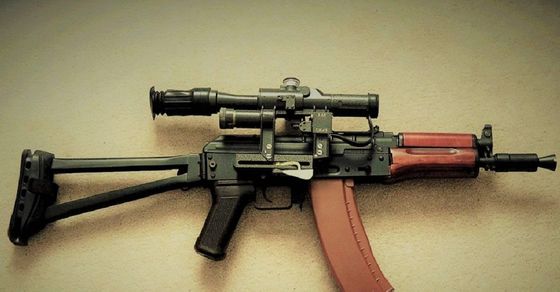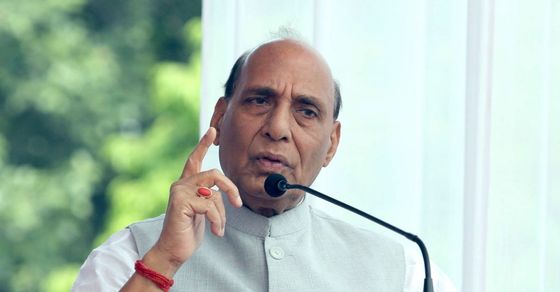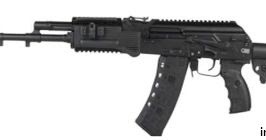WolfPack86
New Member
- Joined
- Oct 20, 2015
- Messages
- 10,571
- Likes
- 16,993
Do the #MakeInIndia products also fall into import embargo category ? If not then what will be the fate of AK production facility in India ?

likelyJUST IN: Indian MoD says it has accorded approvals that are “likely to speed up the procurement of AK-203”.
| India on Tuesday approved measures to speed up long-pending projects to arm its Israeli drones with deadly weapons and indigenously manufacture Russian Kalashnikov assault rifles, while also clearing procurements worth Rs 8,722 crore of basic trainer aircraft, naval guns and specialized anti-tank ammunition. The decision by the Rajnath Singh-led defence acquisitions council (DAC) to fast-track the almost decade-old proposal to arm the Israeli Heron drones, in particular, is significant since it comes amidst the ongoing military confrontation with China in eastern Ladakh. Sources said “Project Cheetah” to upgrade the Heron unmanned aerial vehicles (UAVs) with laser-guided bombs, air-to-ground anti-tank missiles and other precision-guided munitions as well as advanced reconnaissance capabilities will cost over Rs 3,500 crore. “The commercial contract negotiation for the drones’ upgrade was completed long ago. Now, it will be sent to the Cabinet Committee on Security for approval,” said a source. The Indian armed forces have around 90 such medium-altitude, long endurance Heron UAVs, which are currently used for long-range surveillance and precision-targetingmissions. While these drones return after their missions like fighter aircraft, IAF also has some Israeli Harop “killer” or Kamikaze drones that act as cruise missiles by exploding into targets and radars. India is simultaneously also finalizing the plan to acquire the much more advanced Predator-B or weaponized Sea Guardian dronesfrom the US, with six of the proposed 30 drones likely to be procured through the fast-track procurement route now, as was first reported by TOI. The DAC also sorted out “some contractual issues” of the stalled Indo-Russia joint venture to make 6.71 lakh AK-203 rifles, a derivative of the famous AK-47 guns, at Korwa ordnance factory in Amethi district of Uttar Pradesh. TOI had reported in June that the “unreasonable and unacceptable” costs for manufacturing the 7.62x39 mm caliber rifles, at an initial estimated cost of Rs 4,358 crore, had delayed the inking of the final contract. The actual procurements cleared by the DAC on Tuesday included the Rs 7,600 crore one for HTT-40 basic trainer aircraft (BTA), the prototypes of which are undergoing the certification process after being developed by defence PSU Hindustan Aeronautics (HAL). “DAC approved procurement of 106 BTA from HAL to address IAF’s basic training requirements. Post-certification, 70 BTA will initially be procured from HAL and the rest 36 after the HTT-40 fleet becomes operational in IAF,” said the defence ministry. This comes after the government earlier rejected IAF’s case to acquire 38 more Swiss Pilatus trainers, to add to the 75 already inducted under the Rs 2,896 crore deal inked in May 2012, after the foreign company was found to have hired absconding arms dealer Sanjay Bhandari, as was reported by TOI earlier. The DAC also approved procurement of an upgraded version of the 76mm super rapid gun mount (SRGM) medium-range guns, which are fitted on naval and Coast Guard ships, from Bharat Heavy Electricals Limited (BHEL). “The upgraded SRGM version has enhanced capability to perform against fast manoeuvring targets like missiles and fast-attack crafts, while increasing the maximum engagement range. It will boost the Navy’s firepower,” said the MoD. With the availability of requisite capability for indigenous development of ammunition, both in terms of manufacturing and technology, the DAC also approved procurement of 125 mm APFSDS (armour piercing fin stabilized discarding sabot) ammunition for the Army as a “design and development case”. The ammunition being procured will have a 70% indigenous content, said the MoD. |
| India on Tuesday approved measures to speed up long-pending projects to arm its Israeli drones with deadly weapons and indigenously manufacture Russian Kalashnikov assault rifles, while also clearing procurements worth Rs 8,722 crore of basic trainer aircraft, naval guns and specialized anti-tank ammunition. The decision by the Rajnath Singh-led defence acquisitions council (DAC) to fast-track the almost decade-old proposal to arm the Israeli Heron drones, in particular, is significant since it comes amidst the ongoing military confrontation with China in eastern Ladakh. Sources said “Project Cheetah” to upgrade the Heron unmanned aerial vehicles (UAVs) with laser-guided bombs, air-to-ground anti-tank missiles and other precision-guided munitions as well as advanced reconnaissance capabilities will cost over Rs 3,500 crore. “The commercial contract negotiation for the drones’ upgrade was completed long ago. Now, it will be sent to the Cabinet Committee on Security for approval,” said a source. The Indian armed forces have around 90 such medium-altitude, long endurance Heron UAVs, which are currently used for long-range surveillance and precision-targetingmissions. While these drones return after their missions like fighter aircraft, IAF also has some Israeli Harop “killer” or Kamikaze drones that act as cruise missiles by exploding into targets and radars. India is simultaneously also finalizing the plan to acquire the much more advanced Predator-B or weaponized Sea Guardian dronesfrom the US, with six of the proposed 30 drones likely to be procured through the fast-track procurement route now, as was first reported by TOI. The DAC also sorted out “some contractual issues” of the stalled Indo-Russia joint venture to make 6.71 lakh AK-203 rifles, a derivative of the famous AK-47 guns, at Korwa ordnance factory in Amethi district of Uttar Pradesh. TOI had reported in June that the “unreasonable and unacceptable” costs for manufacturing the 7.62x39 mm caliber rifles, at an initial estimated cost of Rs 4,358 crore, had delayed the inking of the final contract. The actual procurements cleared by the DAC on Tuesday included the Rs 7,600 crore one for HTT-40 basic trainer aircraft (BTA), the prototypes of which are undergoing the certification process after being developed by defence PSU Hindustan Aeronautics (HAL). “DAC approved procurement of 106 BTA from HAL to address IAF’s basic training requirements. Post-certification, 70 BTA will initially be procured from HAL and the rest 36 after the HTT-40 fleet becomes operational in IAF,” said the defence ministry. This comes after the government earlier rejected IAF’s case to acquire 38 more Swiss Pilatus trainers, to add to the 75 already inducted under the Rs 2,896 crore deal inked in May 2012, after the foreign company was found to have hired absconding arms dealer Sanjay Bhandari, as was reported by TOI earlier. The DAC also approved procurement of an upgraded version of the 76mm super rapid gun mount (SRGM) medium-range guns, which are fitted on naval and Coast Guard ships, from Bharat Heavy Electricals Limited (BHEL). “The upgraded SRGM version has enhanced capability to perform against fast manoeuvring targets like missiles and fast-attack crafts, while increasing the maximum engagement range. It will boost the Navy’s firepower,” said the MoD. With the availability of requisite capability for indigenous development of ammunition, both in terms of manufacturing and technology, the DAC also approved procurement of 125 mm APFSDS (armour piercing fin stabilized discarding sabot) ammunition for the Army as a “design and development case”. The ammunition being procured will have a 70% indigenous content, said the MoD. |

 theprint.in
theprint.in

 theprint.in
theprint.in


The Defense exhibition Model that was put on Display didn't had ""enhanced grip, foldable and adjustable buttstock, and an extra finger trigger tab give it the clear edge.""Russian deal for 6 lakh AK-203 rifles nearly done, reports say: How it will give lethal edge to Indian troops
The deal between India and Russia for the production of 6 lakh AK-203 rifles under the ‘Make in India’ policy has reportedly been finalised and the signing process is set to start soon.
According to a report in The Print, the production could start as early as the end of this year.
India’s troops have been waiting to get their hands on a state-of-the-art rifle for some years now.
So when news emerged last year that Russia’s defence manufacturer Kalashnikov Concern and India were in negotiations for manufacturing a version of the legendary Kalashnikov rifle in Indian factories (such as the one in Amethi), most Indian military observers agreed that this was long overdue.
Subsequent events at the border with China this year have only magnified the urgency of quickly shoring up India’s firepower – and the modernised AK-203 rifles are a step in that direction.
The AK-203 is a new version of the legendary AK-47 assault rifle.
The decision to procure these came after multiple complaints from troops on the ground that the performance of the Indian Small Arms System (INSAS) rifles was below par.
The Indian Army’s search for a rifle to replace them culminated in the Kalashnikov. The fact that Russia is India’s largest arms supplier helped smoothen and fast-track the process.
A flagship of the Russian small arms industry, Kalashnikov Concern manufactures 95 per cent of all small arms in Russia.
Interestingly, India has also reportedly doubled the order for the initial batch of the 72,400 American Sig Sauer assault rifles amid the ongoing tensions with China. But the bulk of the replacements for the INSAS rifles will be the AK-203, manufactured in Uttar Pradesh’s Amethi.
All about the AK-203
While both the AK-203 and INSAS have a rotary bolt-locking system and are gas operated, the former’s enhanced grip, foldable and adjustable buttstock, and an extra finger trigger tab give it the clear edge.
While the INSAS (5.56 x 45 mm) can be used in a three-round burst and single shot mode, the AK-203 (7.62 x 39 mm) has a semi-automatic and automatic mode.
The AK-203 also has the advantage of being the lighter among the two rifles. Further, the AK-203 has clinical accuracy and carries more bullets. Like the INSAS, the AK-203’s effective range is around 400 metres.
Soldiers’ complaints with the INSAS have included gun jamming, oil drips and the rifle entering the auto mode on its own.
The AK-203 is a world-class, all-weather durable rifle that can carry a knife-bayonet or 40-mm under-barrel grenade launcher, according to the Kalashnikov website. It also comes with a side dove-tail mounting rail that enhances night sights.
The fire accuracy of cyclic bursts is far superior thanks to the AK-203’s muzzle brakes.

Russian deal for 6 lakh AK-203 rifles nearly done, reports say: How it will give lethal edge to Indian troops
When news emerged that Russia’s Kalashnikov and India were in negotiations for manufacturing a version of the legendary rifle in Amethi, Indian military observers agreed this was long overdue.www.timesnownews.com



